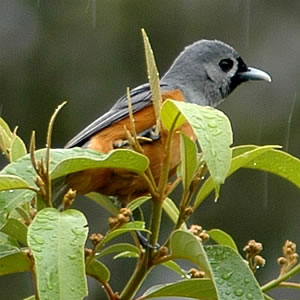|
Kauaʻi ʻelepaio
The Kauai elepaio (''Chasiempis sclateri'') is a monarch flycatcher found on the Hawaiian Island of Kauai. It numbered 40,000 around 1970, but declined by half in the 1990s. Whether this fluctuation is natural and thus the birds' numbers will rebound or whether it signifies a novel threat remains to be seen. However, it seems the birds are making a recovery, as population density on the Alakai plateau has increased by 13% in recent years. Taxonomy and systematics The Kauai elepaio was formerly considered as a subspecies of the Hawaii elepaio (''Chasiempis sandwichensis sclateri'') until reclassified as a separate species in 2010. Description This is the most distinct elepaio; adult birds have their head and back gray, with a white supercilium The supercilium is a plumage feature found on the heads of some bird species. It is a stripe which runs from the base of the bird's beak above its eye, finishing somewhere towards the rear of the bird's head.Dunn and Alderfer (2006), p ... [...More Info...] [...Related Items...] OR: [Wikipedia] [Google] [Baidu] |
Robert Ridgway
Robert Ridgway (July 2, 1850 – March 25, 1929) was an American ornithologist specializing in systematics. He was appointed in 1880 by Spencer Fullerton Baird, secretary of the Smithsonian Institution, to be the first full-time curator of birds at the United States National Museum, a title he held until his death. In 1883, he helped found the American Ornithologists' Union, where he served as officer and journal editor. Ridgway was an outstanding descriptive taxonomist, capping his life work with ''The Birds of North and Middle America'' (eight volumes, 1901–1919). In his lifetime, he was unmatched in the number of North American bird species that he species description, described for science. As technical illustrator, Ridgway used his own paintings and outline drawings to complement his writing. He also published two books that systematized color names for describing birds, ''A Nomenclature of Colors for Naturalists'' (1886) and ''Color Standards and Color Nomenclature'' ... [...More Info...] [...Related Items...] OR: [Wikipedia] [Google] [Baidu] |
Monarch Flycatcher
The monarchs or monarch flycatchers (family Monarchidae) comprise a family of over 100 passerine birds which includes shrikebills, paradise flycatchers, and Grallina, magpie-larks. Monarchids are small insectivore, insectivorous songbirds with long tails. They inhabit forest or woodland across sub-Saharan Africa, south-east Asia, Australasia, and a number of Pacific islands. Only a few species migrate. Many species decorate their cup-shaped nests with lichen. Taxonomy Some of the one hundred or more species making up the family were previously assigned to other groups, largely on the basis of general morphology or behaviour. The magpie-lark, for example, was assigned to the same family as the white-winged chough, since both build unusual nests from mud rather than vegetable matter. That family, Grallinidae, is now considered a Synonym (taxonomy), synonym of Monarchidae. It was formerly considered to have four species. The magpie-lark and the torrent-lark were moved into Monarc ... [...More Info...] [...Related Items...] OR: [Wikipedia] [Google] [Baidu] |
Kauai
Kauai (), anglicized as Kauai ( or ), is one of the main Hawaiian Islands. It has an area of 562.3 square miles (1,456.4 km2), making it the fourth-largest of the islands and the 21st-largest island in the United States. Kauai lies 73 miles (117 km) northwest of Oahu, across the Kauai Channel. The island's 2020 population was 73,298. Styling itself the "Garden Isle", Kauai is the site of Waimea Canyon State Park and Nā Pali Coast State Park. It forms the bulk of Kauai County, which includes Niihau as well as the small nearby islands of Kaula and Lehua. Etymology and language Hawaiian narrative derives the name's origin from the legend of Hawaiiloa, the Polynesian navigator credited with discovering the Hawaiian Islands. The story relates that he named the island after a favorite son; a possible translation of Kauai is "place around the neck", describing how a father would carry his child. Another possible translation is "food season". Kauai was known for its ... [...More Info...] [...Related Items...] OR: [Wikipedia] [Google] [Baidu] |
Subspecies
In Taxonomy (biology), biological classification, subspecies (: subspecies) is a rank below species, used for populations that live in different areas and vary in size, shape, or other physical characteristics (Morphology (biology), morphology), but that can successfully interbreed. Not all species have subspecies, but for those that do there must be at least two. Subspecies is abbreviated as subsp. or ssp. and the singular and plural forms are the same ("the subspecies is" or "the subspecies are"). In zoology, under the International Code of Zoological Nomenclature, the subspecies is the only taxonomic rank below that of species that can receive a name. In botany and mycology, under the International Code of Nomenclature for algae, fungi, and plants, other infraspecific name, infraspecific ranks, such as variety (botany), variety, may be named. In bacteriology and virology, under standard International Code of Nomenclature of Prokaryotes, bacterial nomenclature and virus clas ... [...More Info...] [...Related Items...] OR: [Wikipedia] [Google] [Baidu] |
Hawaii Elepaio
Hawaii ( ; ) is an island state of the United States, in the Pacific Ocean about southwest of the U.S. mainland. One of the two non-contiguous U.S. states (along with Alaska), it is the only state not on the North American mainland, the only state that is an archipelago, and the only state in the tropics. Hawaii consists of 137 volcanic islands that comprise almost the entire Hawaiian archipelago (the exception, which is outside the state, is Midway Atoll). Spanning , the state is physiographically and ethnologically part of the Polynesian subregion of Oceania. Hawaii's ocean coastline is consequently the fourth-longest in the U.S., at about . The eight main islands, from northwest to southeast, are Niihau, Kauai, Oahu, Molokai, Lānai, Kahoolawe, Maui, and Hawaii, after which the state is named; the last is often called the "Big Island" or "Hawaii Island" to avoid confusion with the state or archipelago. The uninhabited Northwestern Hawaiian Islands make up most o ... [...More Info...] [...Related Items...] OR: [Wikipedia] [Google] [Baidu] |




